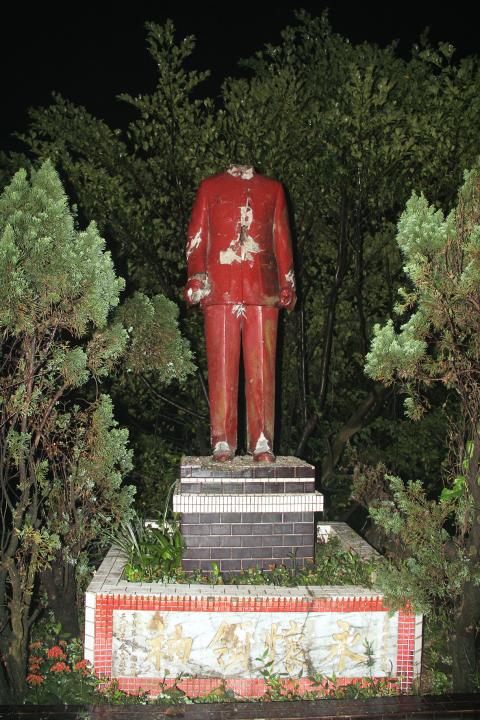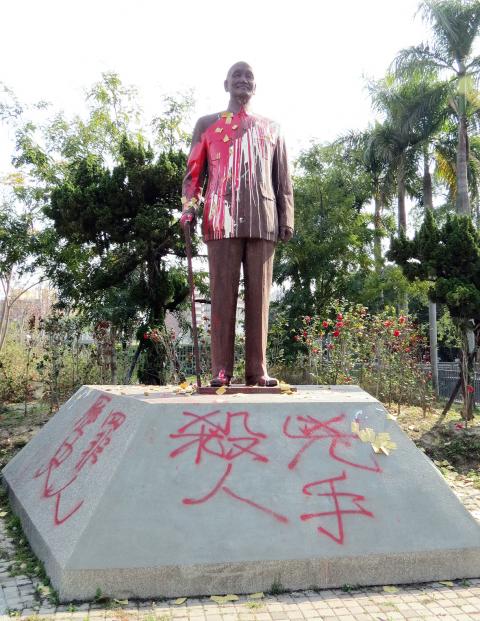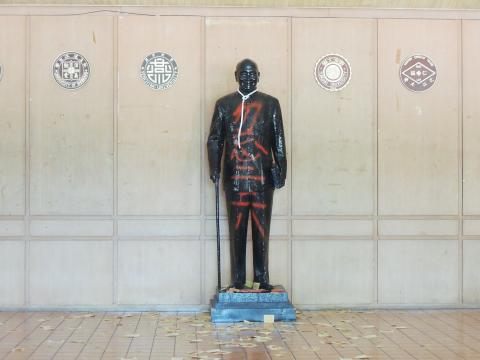An unusually high number of protests targeting statues of former president Chiang Kai-shek (蔣介石) have been reported across the nation in the wake of the 68th anniversary of the 228 Incident on Saturday.
A statue of Chiang erected in Taichung City’s Jhongjheng Park (中正公園) was found yesterday morning covered with white and red paint as well as ghost money, with the Chinese characters for “killer” and “villain” spray-painted on its pedestal.
Police said it was the second defacement of the stone statue in two days. On Saturday morning, it was discovered with the Chinese character for “murderer” spray-painted on its base. City workers removed the graffiti later that day.

Photo: Wu Cheng-feng, Taipei Times
Taichung’s Construction Bureau director Huang Yu-lin (黃玉霖) said the agency has teamed up with the city’s Education Bureau in investigating if other statues of Chiang have been vandalized.
The city government said that just four of the city’s approximately 400 parks have statues of Chiang and that it would consider whether to keep or relocate them once the investigation has been concluded.
It said no charges would be filed against whoever is responsible, as the spray-painted slogans are considered to be equivalent to stains, but that police presence in the areas involved would be increased.

Photo: Chang Ching-ya, Taipei Times
Meanwhile, in northern Taiwan, a beheaded statue of Chiang depicted in two photographs posted on a Facebook page titled “Indefinite Support to Art Installations Featuring Chiang” (無限期支持—全台裝置藝術蔣) on Saturday has been confirmed to be located in a park in Keelung.
Investigators said the fiberglass-based statue’s head was smashed to pieces, and the statue’s torso and ankles were damaged. They added that the perpetrators apparently attempted to knock the sculpture down before realizing that its legs are made of steel and concrete.
Statues of Chiang erected within Taoyuan’s Jhongjheng Park and in front of the Taoyuan Railway Station were also vandalized.

Photo: Tsai Shu-yuan, Taipei Times
In addition, sculptures of Chiang on campuses nationwide have been defaced over the past few days, including ones at Taipei First Girls’ High School, Taipei Municipal Daan Vocational High School, National Chutung Senior High School, Tunghai University and National Taipei University of Technology.
Tunghai University chief secretary Lu Ping-kuan (呂炳寬) said the school’s statue of Chiang and the Chiang Kai-shek Memorial Hall have existed for nearly three decades and carry historical significance to the university.
“While the school respects students’ opinions and is open to discussions regarding the hall’s renaming and the statue’s removal, they must be expressed in a rational manner,” Lu said, adding that vandalism would be dealt with in accordance with school regulations.

The US government has signed defense cooperation agreements with Japan and the Philippines to boost the deterrence capabilities of countries in the first island chain, a report by the National Security Bureau (NSB) showed. The main countries on the first island chain include the two nations and Taiwan. The bureau is to present the report at a meeting of the legislature’s Foreign Affairs and National Defense Committee tomorrow. The US military has deployed Typhon missile systems to Japan’s Yamaguchi Prefecture and Zambales province in the Philippines during their joint military exercises. It has also installed NMESIS anti-ship systems in Japan’s Okinawa

‘WIN-WIN’: The Philippines, and central and eastern European countries are important potential drone cooperation partners, Minister of Foreign Affairs Lin Chia-lung said Minister of Foreign Affairs Lin Chia-lung (林佳龍) in an interview published yesterday confirmed that there are joint ventures between Taiwan and Poland in the drone industry. Lin made the remark in an exclusive interview with the Chinese-language Liberty Times (the Taipei Times’ sister paper). The government-backed Taiwan Excellence Drone International Business Opportunities Alliance and the Polish Chamber of Unmanned Systems on Wednesday last week signed a memorandum of understanding in Poland to develop a “non-China” supply chain for drones and work together on key technologies. Asked if Taiwan prioritized Poland among central and eastern European countries in drone collaboration, Lin

Renewed border fighting between Thailand and Cambodia showed no signs of abating yesterday, leaving hundreds of thousands of displaced people in both countries living in strained conditions as more flooded into temporary shelters. Reporters on the Thai side of the border heard sounds of outgoing, indirect fire yesterday. About 400,000 people have been evacuated from affected areas in Thailand and about 700 schools closed while fighting was ongoing in four border provinces, said Thai Rear Admiral Surasant Kongsiri, a spokesman for the military. Cambodia evacuated more than 127,000 villagers and closed hundreds of schools, the Thai Ministry of Defense said. Thailand’s military announced that

CABINET APPROVAL: People seeking assisted reproduction must be assessed to determine whether they would be adequate parents, the planned changes say Proposed amendments to the Assisted Reproduction Act (人工生殖法) advanced yesterday by the Executive Yuan would grant married lesbian couples and single women access to legal assisted reproductive services. The proposed revisions are “based on the fundamental principle of respecting women’s reproductive autonomy,” Cabinet spokesperson Michelle Lee (李慧芝) quoted Vice Premier Cheng Li-chiun (鄭麗君), who presided over a Cabinet meeting earlier yesterday, as saying at the briefing. The draft amendment would be submitted to the legislature for review. The Ministry of Health and Welfare, which proposed the amendments, said that experts on children’s rights, gender equality, law and medicine attended cross-disciplinary meetings, adding that